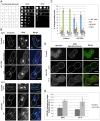Licensing of yeast centrosome duplication requires phosphoregulation of sfi1
- PMID: 25340401
- PMCID: PMC4207612
- DOI: 10.1371/journal.pgen.1004666
Licensing of yeast centrosome duplication requires phosphoregulation of sfi1
Abstract
Duplication of centrosomes once per cell cycle is essential for bipolar spindle formation and genome maintenance and is controlled in part by cyclin-dependent kinases (Cdks). Our study identifies Sfi1, a conserved component of centrosomes, as the first Cdk substrate required to restrict centrosome duplication to once per cell cycle. We found that reducing Cdk1 phosphorylation by changing Sfi1 phosphorylation sites to nonphosphorylatable residues leads to defects in separation of duplicated spindle pole bodies (SPBs, yeast centrosomes) and to inappropriate SPB reduplication during mitosis. These cells also display defects in bipolar spindle assembly, chromosome segregation, and growth. Our findings lead to a model whereby phosphoregulation of Sfi1 by Cdk1 has the dual function of promoting SPB separation for spindle formation and preventing premature SPB duplication. In addition, we provide evidence that the protein phosphatase Cdc14 has the converse role of activating licensing, likely via dephosphorylation of Sfi1.
Conflict of interest statement
The authors have declared that no competing interests exist.
Figures




Similar articles
-
Duplication of the Yeast Spindle Pole Body Once per Cell Cycle.Mol Cell Biol. 2016 Apr 15;36(9):1324-31. doi: 10.1128/MCB.00048-16. Print 2016 May. Mol Cell Biol. 2016. PMID: 26951196 Free PMC article. Review.
-
Molecular mechanisms that restrict yeast centrosome duplication to one event per cell cycle.Curr Biol. 2014 Jul 7;24(13):1456-66. doi: 10.1016/j.cub.2014.05.032. Epub 2014 Jun 19. Curr Biol. 2014. PMID: 24954044
-
Big Lessons from Little Yeast: Budding and Fission Yeast Centrosome Structure, Duplication, and Function.Annu Rev Genet. 2017 Nov 27;51:361-383. doi: 10.1146/annurev-genet-120116-024733. Epub 2017 Sep 15. Annu Rev Genet. 2017. PMID: 28934593 Review.
-
Budding yeast Swe1 is involved in the control of mitotic spindle elongation and is regulated by Cdc14 phosphatase during mitosis.J Biol Chem. 2015 Jan 2;290(1):1-12. doi: 10.1074/jbc.M114.590984. Epub 2014 Nov 18. J Biol Chem. 2015. PMID: 25406317 Free PMC article.
-
Cell cycle control of spindle pole body duplication and splitting by Sfi1 and Cdc31 in fission yeast.J Cell Sci. 2015 Apr 15;128(8):1481-93. doi: 10.1242/jcs.159657. Epub 2015 Mar 3. J Cell Sci. 2015. PMID: 25736294
Cited by
-
The half-bridge component Kar1 promotes centrosome separation and duplication during budding yeast meiosis.Mol Biol Cell. 2018 Aug 1;29(15):1798-1810. doi: 10.1091/mbc.E18-03-0163. Epub 2018 May 30. Mol Biol Cell. 2018. PMID: 29847244 Free PMC article.
-
Disappearance of Cdc14 from the daughter spindle pole body requires Glc7-Bud14.Turk J Biol. 2024 Sep 17;48(5):308-318. doi: 10.55730/1300-0152.2707. eCollection 2024. Turk J Biol. 2024. PMID: 39474039 Free PMC article.
-
The budding yeast RSC complex maintains ploidy by promoting spindle pole body insertion.J Cell Biol. 2018 Jul 2;217(7):2445-2462. doi: 10.1083/jcb.201709009. Epub 2018 Jun 6. J Cell Biol. 2018. PMID: 29875260 Free PMC article.
-
Centrosome Remodelling in Evolution.Cells. 2018 Jul 6;7(7):71. doi: 10.3390/cells7070071. Cells. 2018. PMID: 29986477 Free PMC article. Review.
-
Cleavage of the SUN-domain protein Mps3 at its N-terminus regulates centrosome disjunction in budding yeast meiosis.PLoS Genet. 2017 Jun 13;13(6):e1006830. doi: 10.1371/journal.pgen.1006830. eCollection 2017 Jun. PLoS Genet. 2017. PMID: 28609436 Free PMC article.
References
Publication types
MeSH terms
Substances
Grants and funding
LinkOut - more resources
Full Text Sources
Other Literature Sources
Molecular Biology Databases
Miscellaneous

